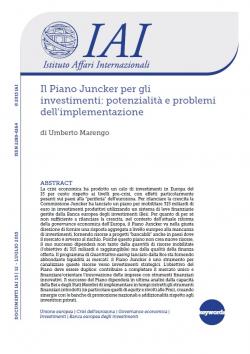Il Piano Juncker per gli investimenti: potenzialità e problemi dell'implementazione
The economic crisis has resulted a 15% fall in investments in Europe compared to pre-crisis levels. Its effects were particularly heavy on the countries at the “periphery” of the Eurozone. To boost economic growth, the Juncker Commission launched a plan to mobilize 315 billion Euro towards productive investments through a system of financial leverages managed by the European Investment Bank (EIB). This will not be sufficient in itself to reignite economic growth but, in the context of the ongoing reform of European economic governance, the "Plan Juncker" goes in the right direction. It responds to the lack of investments with an aggregated European instrument that provides resources to "bankable" projects that may be based in countries where markets are excessively risk averse. Since this plan does not "create" new resources, its success will depend not so much on the amount of resources it mobilizes (the target of 315 billion is reacheble) but on the quality of the finance it offers. The "Juncker Plan" is a tool to channel towards strategic investments the ample liquidity provided by the Quantitative Easing program launched by the ECB. The objective of the plan must be twofold: to help complete the European single market and to finance/orient private sector innovation through a new generation of financial instruments. The success of the plan will ultimately depend on the capacity of the EIB and the Member States to implement the financial instruments that have been introduced (in particular on equity financing and SMEs) within a short time-frame, creating synergies with the National Promotion Banks and “additionallity” vis-à-vis private investors.
Paper prepared for the Istituto Affari Internazionali (IAI) and presented at the conference “Tornare a investire in Europa. Piano Juncker: un buon inizio?”, organised in Turin on 3 July 2015 by the IAI and the Centro studi sul federalismo (Csf), within the framework of the series of conferences on “The Future of the European Economy”.
-
Details
Roma, IAI, July 2015, 13 p. -
In:
-
Issue
15|12
1. Il calo degli investimenti in Europa è stato pro-ciclico e asimmetrico
2. Il Piano Junker: struttura e fattibilità della leva finanziaria
3. L’obiettivo del Piano è canalizzare le risorse verso l’economia reale
4. Finanziare il completamento del mercato unico e imprese innovative
5. La questione aperta è l’implementazione: governance e sinergie con banche nazionali e Bce
Conclusioni
Box 1. La Banca europea degli investimenti: quanto vale e cosa fa
Riferimenti
Topic
Tag
Related content
-
Event25/06/2015
Tornare a investire in Europa: Piano Juncker: un buon inizio?
leggi tutto -
Ricerca06/01/2014
The future of the European economy
leggi tutto



